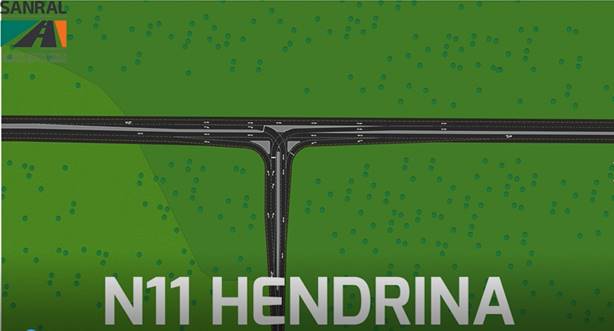The new road will be much safer than the existing road with provision of 3-meter paved shoulders, construction of a new bridge, provision of passing lanes and upgrading of the roadway through the town section.

Road construction is one of the most challenging and demanding jobs. Every project brings new challenges which require civil engineers to think out of the box.
The upgrading of the N11 from Hendrina to the Hendrina power station undertaken by the South African National Roads Agency (SOC) Limited (SANRAL) is one such example.
The road is an important route for coal haulage and transportation of agricultural produce in Mpumalanga.
On average, it carries 2 500 to 3 000 vehicles in one direction per day, mostly heavy trucks from the mines.
The Project
The main aim of the project is to strengthen the existing pavement, which is past its structural design life and is generally in a poor condition and introduce new features to make it safer for motorists.
Because it’s an already existing road, the project presented contractors with some technical challenges.
According to Progress Hlahla, Regional Manager SANRAL northern region, the project had to be split into 18 separate construction sections because of the various difficulties encountered, and complexity of dealing with construction of bridges, building of a temporary bypass for accommodating of passing traffic, high water table in the fills, various services in the way such as water mains, and fibre optic cables.
The new road will be much safer than the existing road with provision of 3-meter paved shoulders, construction of a new bridge, provision of passing lanes and upgrading of the roadway through the town section.
“The first test was to build a bypass along the new road to accommodate passing traffic,” said Hlahla.
Challenges
A major challenge was the relocation of services along the road such as the Telkom and Dark Fibre optic cables and dealing with two water main pipes that run parallel to the road.
It was found that the water mains were in the way for the widening and reconstruction of major culverts and bridges and had to be diverted in order to accommodate the road.
The deviation of these water mains (which service the town from the Optimum mine) was a major headache and impacted negatively on the contractor’s construction programme.
Hlahla said: “We encountered a very high-water table under the road in the town section, which required installation of a new subsoil drainage system to deal with the underground water. The municipality were called in to ensure that the high-water table was not artificially created by leaking of municipal water mains. In general, SANRAL had a good working relationship with the local municipality.
“We are also going to be upgrading the intersection at the Hendrina Secondary School into a traffic circle and will be installing new LED street lighting as well as implementing 5 new bus-stop shelters for convenience of non- motorists.”
Once completed the N11, previously designed for a speed of 80km per hour, will now be much safer and wider to accommodate vehicles travelling at 100km per hour.
Project information:
Project title: Upgrading of the N11 from Hendrina to the Hendrina Power station (20km).
Project value: R 275-million – 20% to be allocated to SMMEs including women owned and youth owned.
Contractors: Power Construction.
Project scope: Construction of layer works, widening of lanes – to 3,7m with 3m surfaced shoulders, – construction of bridges, a traffic circle and reconstruction of kerbs.
Duration: Original contract duration 26 months – delays of 5 months encountered. Contract started November 2016. Expected completion April 2019.

